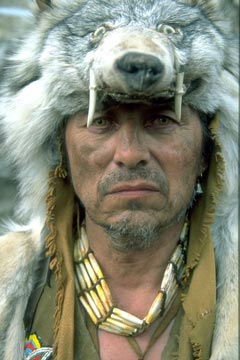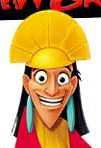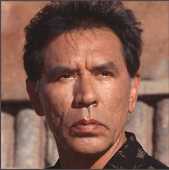While Canada has broadcast several series starring Natives, here's a rundown of TV's pathetically poor record in the US:
Three live-action shows, none of which featured full-fledged Native actors:
Broken Arrow
Hawk
Nakia
(Broken Arrow starred John Lupton as Tom Jeffords and Michael Ansara as Cochise. I haven't seen the TV show, but it sounds as though Jeffords and Cochise were considered co-leads.)
Five cartoons, two of which feature animals as Indians, and none of them voiced by Native actors:
The Adventures of Pow Wow, the Indian Boy
The Go-Go Gophers
The Paw Paws
BraveStarr
The Emperor's New School
Incredibly, we'd have to give the prize to The Emperor's New School for the most Native characters in an American network series. Unfortunately, they're only pseudo-Natives, with no real Native characteristics.
After thousands of TV shows over 60 years, we've never had an American network series whose main character was a Native played or voiced by a Native actor. What a sad testimony to Hollywood's racial blinders.
Note: Obviously the US networks have aired made-for-TV movies and documentaries starring Natives. And at least one mini-series, if you count Dreamkeeper or the Hillerman mystery movies. But I'm talking about regular weekly series here, not one-time specials.




6 comments:
Writerfella here -
You're saying SELF-IDENTIFIED Native actors, yes? Burt Reynolds (HAWK) is 1/4th Seminole. Robert Forster (NAKIA) is 1/8th Cherokee from North Carolina. What Native actors there once existed quickly found that, if they self-identified as Native, they only received consideration for Native parts. Period. Thus, they deep-sixed their Native identities and went on to have long and productive careers otherwise. It may or may not be true today, but then again, why take that chance? By the bye, writerfella self-identified as a Kiowan Native in 1979, when he worked in his first motion picture. After appearing in seven films and one TV series as an actor, writerfella has not gotten an acting job since 1985...
All Best
Russ Bates
'writerfella
I used the word "full-fledged" to include full-blooded Indians, Indians with membership in a fully recognized tribe, and Indians who fully identify themselves as Indians. Burt Reynolds and Robert Forster don't qualify by any of these standards.
Why should actors "take a chance" on identifying themselves as Indians today? Uh, because the networks are actively seeking to diversify their hires? Because any stigma to being an Indian actor ended years ago?
Do you seriously think Wes Studi, Adam Beach, and Irene Bedard are losing jobs because people know they're Indians? Yeah, they're really suffering, all right. Since 2000 they've had 31, 29, and 22 roles respectively, according to IMDB.com. "Only" 3-4 roles per year...they're practically unemployed!
Writerfella here --
Full-blooded? Got some sort of DNA kit that measures true blood quanta, do ya, Rob? With very few exceptions, fullbloods exist in the United States and Canada about equal in numbers to Ishi's people, the Passenger pigeon, and Aztec Rexes. But maybe Congress could create fullbloods just like they create 'tribes'...
All Best
Russ Bates
'writerfella'
I said I used the word "full-fledged" to describe several kinds of Indian--none of which include Reynolds or Forster. If you're too dense to understand what I said, just say so. I'll try to use smaller words to explain it.
As you may or may not be bright enough to realize, many Indians keep track of their blood quantum. Why? So they know whether they or their children qualify for membership in a federally recognized tribe.
You yourself have said you're, what, 15/16 Kiowa? Are you now claiming I forced this blood-quantum classification on you? Or did you somehow measure and quantify it without my help? Duh.
To reiterate, blood quantum is something Indians choose to go by, not something I require them to go by. Like the protests over the word "redskin," they initiated it. Like that controversy, you've wrongly claimed I instigated something when I didn't.
In short, how stupid can you get? Pretty damn stupid, obviously.
P.S. To alleviate your ignorance on the subject, see Educating Russ About Who's an Indian.
Rob said..."As you may or may not be bright enough to realize, many Indians keep track of their blood quantum. Why? So they know whether they or their children qualify for membership in a federally recognized tribe."
Blood quantum was not started by American Indians. As you may or may not be bright enough to know, it was started as legislature by the mainly European American government. Because of the way American Indians were forced to categorize themselves, many have lost their affiliations and culture.
I know the history of blood quantum laws well enough, Kellee. How the laws originated is a different question from how they're implemented today. Tribes choose to use blood-quantum standards to define their membership. The federal government isn't forcing them to do it.
http://en.wikipedia.org/wiki/Blood_quantum_laws
Many Native American tribes did not use blood quantum law until the government introduced the Indian Reorganization Act of 1934.
For decades, tribes have established their own requirements for membership.
http://en.wikipedia.org/wiki/Certificate_of_Degree_of_Indian_Blood
A Certificate Degree of Indian Blood does not establish membership in a tribe. Tribal membership is determined by tribal laws and may or may not require a CDIB or may require a separate tribal determination of ancestry or blood degree.
http://americanindiansource.com/bloodquantum.html
[E]ach tribe has a particular set of requirements, typically including a blood quantum, for membership (enrollment) in the tribe. Requirements vary widely from tribe to tribe: a few tribes require at least a one-half Indian (or tribal) blood quantum; many others require a one-fourth blood quantum; still others, generally in California and Oklahoma, require a one-eighth, one-sixteenth, or one-thirty-second blood quantum; and some tribes have no minimum blood quantum requirement at all but require an explicitly documented tribal lineage.
Post a Comment